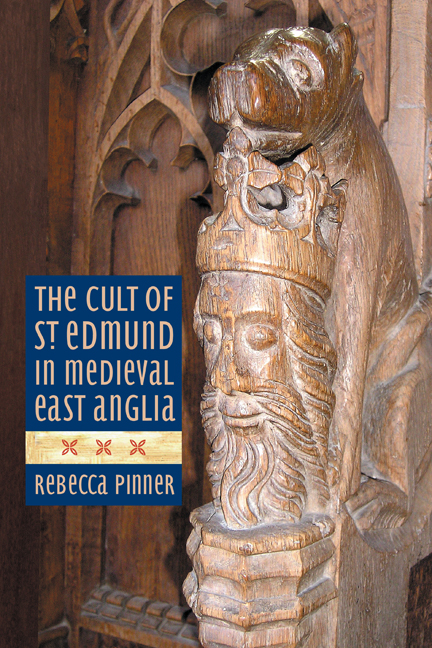Book contents
- Frontmatter
- Contents
- List of Illustrations
- Acknowledgements
- Abbreviations
- Introduction
- Part I Texts and Contexts: the Legend of St Edmund
- Part II Relics, Shrines and Pilgrimage: Encountering St Edmund at Bury
- Part III Beyond Bury: Dissemination and Appropriation
- Conclusion: ‘Martir, Mayde and Kynge’, and More
- Appendix 1 Synoptic Account of the Legend of St Edmund
- Appendix 2 Chronology of Significant Events and Texts Associated with the Cult of St Edmund
- Bibliography
- Index
Chapter 4 - The Elaboration of the Hagiographic Tradition
Published online by Cambridge University Press: 21 May 2021
- Frontmatter
- Contents
- List of Illustrations
- Acknowledgements
- Abbreviations
- Introduction
- Part I Texts and Contexts: the Legend of St Edmund
- Part II Relics, Shrines and Pilgrimage: Encountering St Edmund at Bury
- Part III Beyond Bury: Dissemination and Appropriation
- Conclusion: ‘Martir, Mayde and Kynge’, and More
- Appendix 1 Synoptic Account of the Legend of St Edmund
- Appendix 2 Chronology of Significant Events and Texts Associated with the Cult of St Edmund
- Bibliography
- Index
Summary
Geoffrey of Wells, De Infantia Sancti Eadmundi
THE next major development in the St Edmund legend took place in the mid-twelfth century when Geoffrey of Wells was commissioned to write De infantia sancti Eadmundi by Sihtric, prior of Bury St Edmunds. De Infantia may be dated with some precision: it is dedicated to ‘dominus et pater Ording’, who was abbot of Bury between January 1148 and February 1156. The author also refers to Sihtric as prior at Bury, who was appointed by 1153 at the latest but probably held the post from c.1150.
Geoffrey of Wells was most likely a canon of the abbey's priory at Thetford. There were three religious houses in the close vicinity of Thetford at the time of the text's composition: a Cluniac priory founded by Roger Bigod (d.1107) in about 1104; a house of the Order of the Holy Sepulchre founded by William de Warenne III (d.1148) between 1139 and 1146; and a small community of canons that cared for the parish church of St George, which by Geoffrey's time was a priory of Bury St Edmunds Abbey. Paul Hayward suggests that the dedication of the priory church may account for Geoffrey's specification of the place of Offa's death as ‘at the river which travellers call St George's arm’. Blomefield claims that the priory was founded by Ufi, the first abbot of Bury (1020–44), to commemorate those who had died when Edmund's army fought the Danes at the Battle of Thetford. St George would certainly be an appropriately martial dedication. Regardless of his exact provenance, Geoffrey's close association with Bury is apparent from his claims that he participated in discussions about Edmund with the saint's guardians. He also maintains that Sihtric travelled to Thetford to commission him to write De Infantia.
It is clear that Geoffrey intended his text to be a prequel to Abbo's Passio. De Infantia concludes with the Danes preparing for invasion and, for details of the martyrdom, Geoffrey refers his readers to the version ‘by an eloquent man, Abbo of Fleury’. Geoffrey relates his intention to record ‘the story of the saint's arrival, that is, from Saxony into England’ and duly presents the first account of Edmund's parentage and upbringing and his ascension to the throne of East Anglia.
- Type
- Chapter
- Information
- The Cult of St Edmund in Medieval East Anglia , pp. 75 - 88Publisher: Boydell & BrewerPrint publication year: 2015



